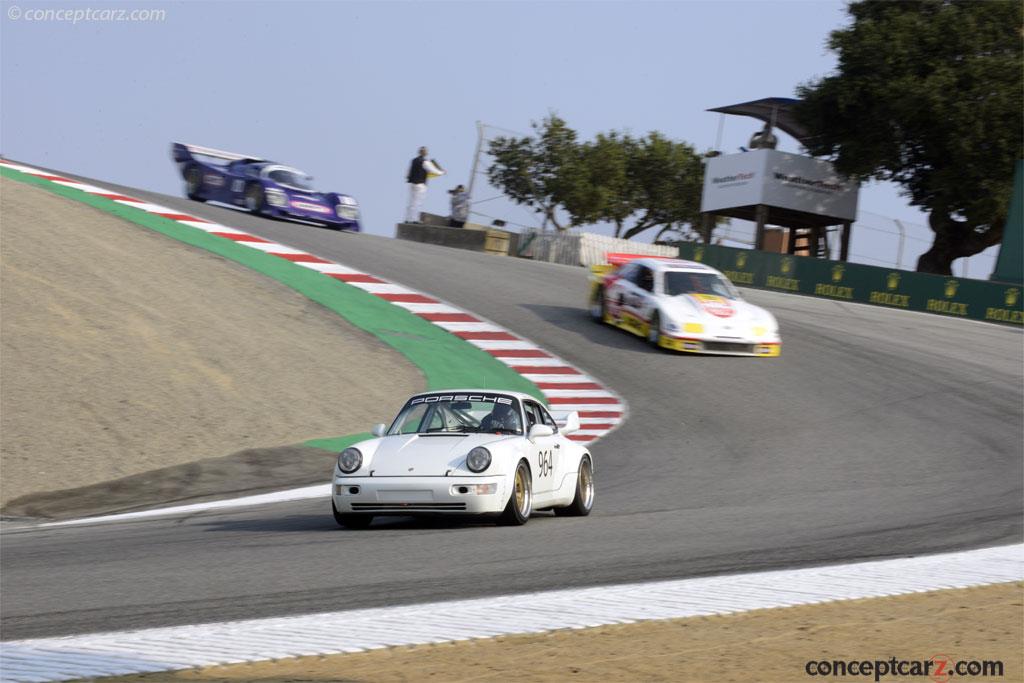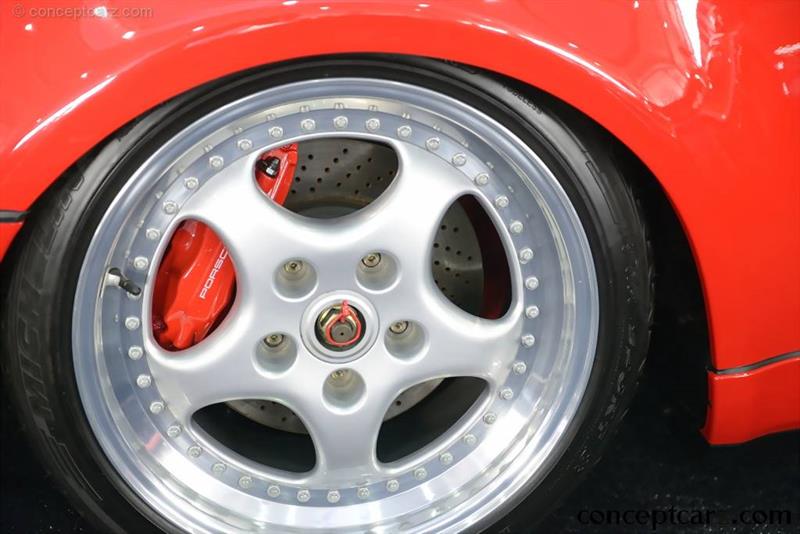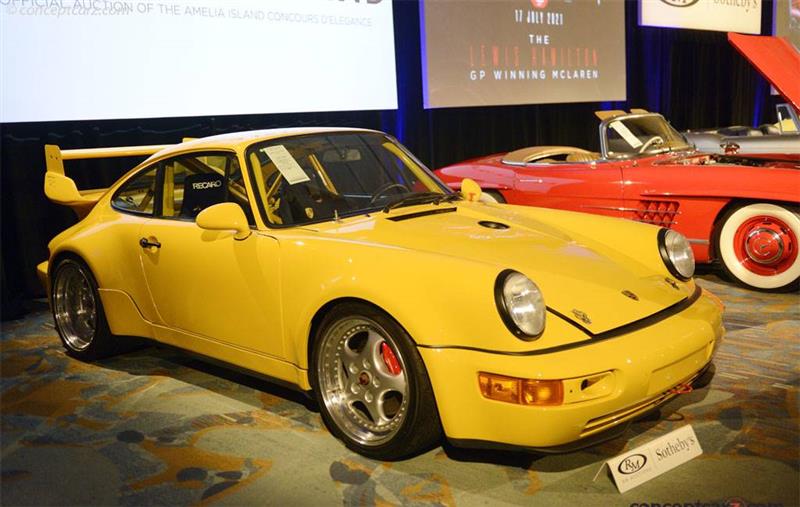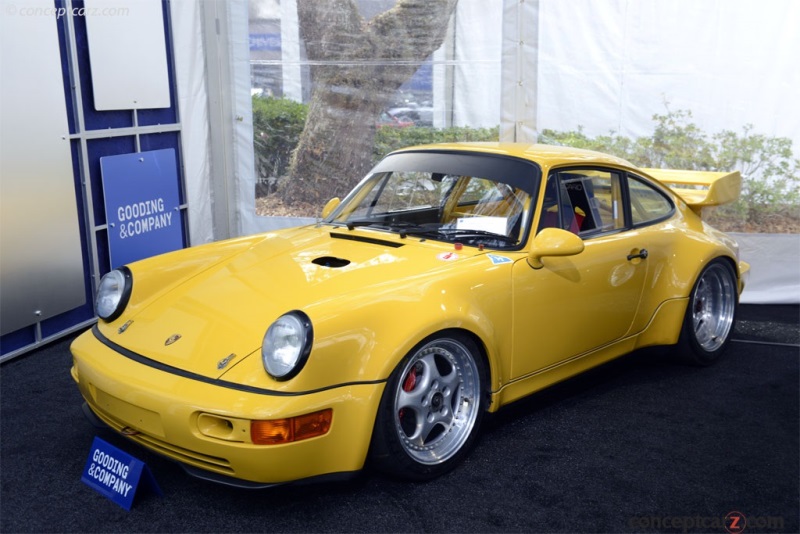Porsche used the 911 Carrera RS 2.7 of 1973 to homologate the 911 Carrera 2.8 RSR (RennSport Rennwagen) for FIA Group 4 racing. The RSR would prove to be a formidable GT competitor, and in its inaugural racing season, it won the Targa Florio, 12 Hours of Sebring, and the 24 Hours of Daytona. Porsche won the World Manufacturers' and IMSA Driver's Championships, and subsequent models continued the dominance with victories in Trans Am, IMSA, and the FIA World Championship.
Coupe
Chassis #: WP0ZZZ96ZPS496086
Engine #: 62P85628
View info and history
Auction entries : 2The Porsche 964 Carrera RSR was aimed at major European GT competition and the North American Supercar series. It was based on the RS 3.8 and reflected Porsche's return to production-based GT racing dominance, using competition underpinnings, lightweight design principles, and a 3.8-liter engine to accomplish this goal. Designed for privateers and a perfect match to international rules that governed GT racing cars, the RSR would become one of the most successful competition versions of the air-cooled 911 in Porsche's history. Mounted in the rear of the Turbo's widebody was a model-specific Type M64/04 3.8-liter air-cooled flat-six, naturally aspirated with 11.4:1 compression, lighter pistons, dual ignition, new intake manifolds with six individual butterflies, dry-sump lubrication, and Bosch electronic fuel injection. Depending on class restrictions, the engine delivered 375 horsepower and 284 foot-pounds of torque, sent to the rear wheels via a racing clutch to an uprated five-speed manual transaxle with 40 percent limited slip. The RSR wore body shells created on the 964 assembly line, with all seams in the tub welded for increased strength. The tubs were painted red, yellow, blue, or black, and then trucked to Wilfried Matter where a full roll cage with side-intrusion protection was welded into the structure. The shells were then returned to Zuffenhausen for completion. An anti-lock braking system was sourced from the Turbo S with competition pads, concealed behind wide, three-piece modular Speedline wheels of 18-inch diameter that was half an inch wider than those of the RS at 9.5 and 11.5 in., respectively. The suspension was lowered by 1.5-inches and used adjustable anti-roll bars, fully adjustable competition Bilstein shocks and struts, and stainless-steel Heim joints. 
Coupe
Chassis #: WP0ZZZ96ZPS496081
View info and history
Auction entries : 1The interior roll-cage, which added considerably to the tub's torsional strength, was fitted with a single Recaro racing bucket seat and a full Shroth six-point racing harness. There was a fire suppression system, windows made of thinner and lighter glass, and air intakes placed in the front bumper. The lightweight composite material was used for both the front and rear bumper fascias, and the front trunk lid and door were fabricated from lightweight aluminum. The trunk lid was secured by the special hold-down clips which had replaced the earlier-style rubber hold-downs.To better support the larger fiberglass bi-lane rear wing used on the 'basic' version, the engine cover was comprised of steel. The front trunk area housed a British-sourced Premier fuel cell with its attendant pumps, and provision was made for through-the-hood refilling. On the floor, ahead of the gearshift, was a small red button that operated a very small reserve fuel system for use in an extreme emergency, helping to prevent the car from going dry while far away from the pits. Behind the front valance rested an additional oil cooler, and a re-mapped Bosch Motronic control box was placed behind the driver's seat. An emergency fire system pull-handle was placed on the cowling ahead of the windshield, and a driver-operable electric master switch was installed in the front trunk. The Porsche 964 Carrera RSR had a dry weight of 2,673 lbs, which was below the class minimum, allowing drivers and teams to add ballast where desired to comply with minimum weight requirements. The cars could be purchased with a built-in pneumatic jack system and center-lock wheels to accelerate pit stop wheel changes. 
Coupe
Chassis #: WP0ZZZ96ZPS496081
View info and history
Auction entries : 1The 964 Carrera RSR was capable of sprinting from zero-to-sixty mph in 3.7 seconds and had a top speed of 181 mph. The quarter-mile was accomplished in 12.1 seconds at 116 mph. With a racing pedigree and all the proper racing ingredients, the RSR 3.8 was immediately successful, taking overall honors at the 1994 Spa 1000 KM with Fittipaldi, Jarier, and Alzen. Hermann, Konrad, and Prangemeier were victorious at the 1000 KM of Interlagos in Brazil. It won its class at the 24 Hours of Lemans with the French team of Pareja, Dupuy, and Palau. The RSR 3.8 enjoyed similar racing success on North American soil, sweeping the first four places in IMSA's GTU category, with the winning car being driven by Richter, Wlazik, Ebeling, and Döbler, placing 3rd overall ahead of the fastest WSC Prototype. At the 12 Hours of Sebring, Ham, Varde, and Sandridge secured another class victory for the RSR 3.8 Porsche. 
Coupe
Chassis #: WP0ZZZ96ZPS496076The RSR 3.8 remained competitive in 1994 and scored class victories through 1995 before Porsche turned its attention to the 993-based GT2 for international competition. Production of the RSR lasted from April of 1993 to December of 1994, with one pre-production RSR 3.8 test car, one factory race car, a delayed run of four cars that have been omitted on many records, plus an additional 49 units, for a total of 55 units. 27 examples were delivered to Germany and 11 were sent to the United States. Great Britain, Italy, and Japan each received three examples. Switzerland and France each received two examples, and a single example was sent to Austria, Australia, Holland, and Monaco. In the United States, the RSR had a base price of $160,500, with the only option being the onboard jacking system, center-lock wheels, and an optional passenger's seat. They were available in PTS (paint to sample) colors, and they were typically ordered in vibrant shades.
by Daniel Vaughan | Jul 2021

Coupe
Chassis #: WP0ZZZ96ZPS496086
Engine #: 62P85628
View info and history
Auction entries : 2

Coupe
Chassis #: WP0ZZZ96ZPS496081
View info and history
Auction entries : 1

Coupe
Chassis #: WP0ZZZ96ZPS496081
View info and history
Auction entries : 1

Coupe
Chassis #: WP0ZZZ96ZPS496076
by Daniel Vaughan | Jul 2021
Related Reading : Porsche 911 History
The legendary Porsche 911 is the longest production run sports car of all time. It was conceived as a successor for the highly successful Porsche 356 and from the start had high aspirations for success. Ferry Porsches son, Ferdinand Alexander Porsche, designed the 911. When it went into production it was labeled the 901 but Peugeot had claims to the name, so to avoid infringing on their naming scheme,....
Continue Reading >>
Continue Reading >>
Related Reading : Porsche 911 History
Who could predict that the 911 would be Porsches saving grace and surpass the 356 in sales, longevity Quickly establishing itself as an icon of 60s cool, the iconic 911 only became more popular as the years went on. The flagship of the current lineup of Porsche, the 911 (pronounced Nine Eleven) or Neunelfer is a two-door grand tourer with a very distinctive design. The 911 is one of the oldest....
Continue Reading >>
Continue Reading >>
1993 Porsche 964 Carrera RSR Vehicle Profiles
Recent Vehicle Additions
Related Automotive News

Singer Presents Dynamics & Lightweighting Study - Turbo
Singers latest restoration services offered to enthusiast owners of the Type 964 air-cooled 911
Turbocharging integrated with the results of the Dynamics %26 Lightweighting Study (DLS)
Personalized at the request of Singers clients for road or tr...

From Lucybelle to DHL: Historic Porsche Competition Cars Race to Gooding & Company's Pebble Beach Auctions
The very best of Porsche excellence will come to Pebble Beach with a 1959 Porsche 718 RSK, a 1969 Porsche 90802, a 2007 Porsche RS Spyder Evo, and more.
Gooding %26 Company, the official auction house of the Pebble Beach Concours dElegance®,...
Brumos Collection Unveils 'Brumos: An American Racing Icon'
Brumos An American Racing Icon
By Sean Cridland
A Look Inside The Three Volumes
Volume I The Brundage Era chronicles the historical events that led to the creation and development of one of the worlds most legendary teamsWith a foreword...

Porsche Honors Hurley Haywood On 70Th Birthday
Endurance racing legend born May 4, 1948
Atlanta, Georgia. Porsche congratulates one of its most decorated ambassadors, Hurley Haywood, on a shared anniversary The five-time Rolex 24 Hours of Daytona winner turns 70 today, just a month before...
Roger Penske to be Honored with IMRRC's 2016 Argetsinger Award for Contributions to Racing
WATKINS GLEN, N.Y. (April 6, 2016) – Roger Penske, one of auto racings most notable team owners, will be honored in June by the International Motor Racing Research Center (IMRRC) with the 2016 Cameron R. Argetsinger Award for Outstanding Contributions...





















